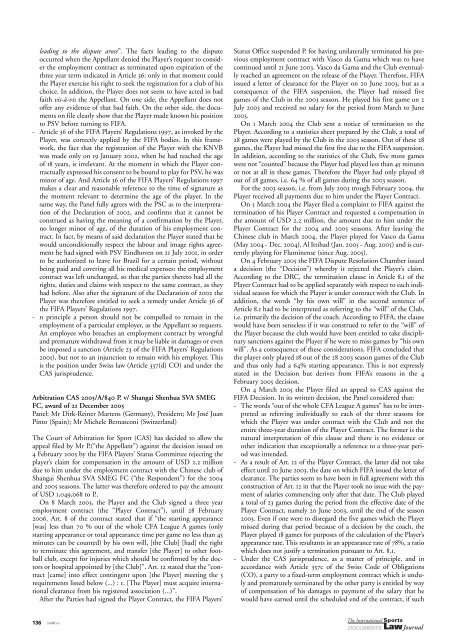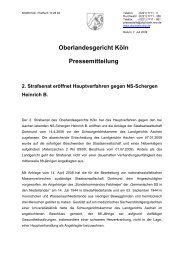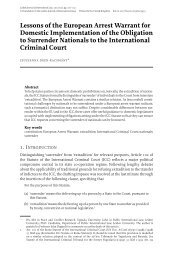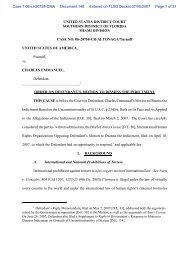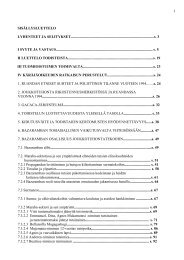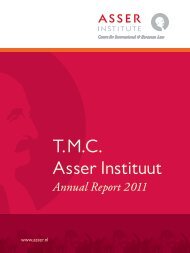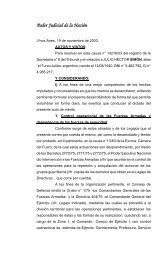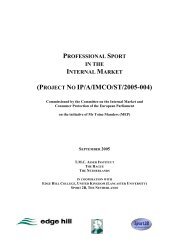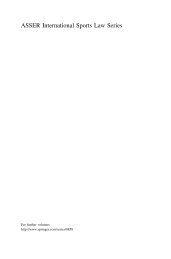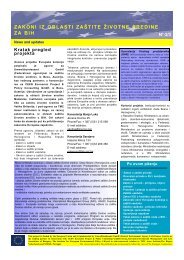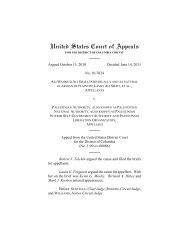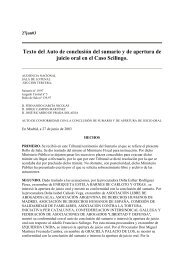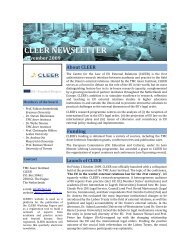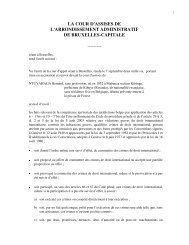leading to the dispute arose”. The facts leading to the disputeoccurred when the Appellant denied the Player’s request to considerthe employment contract as terminated upon expiration of thethree year term indicated in Article 36: only in that moment couldthe Player exercise his right to seek the registration for a club of hischoice. In addition, the Player does not seem to have acted in badfaith vis-à-vis the Appellant. On one side, the Appellant does notoffer any evidence of that bad faith. On the other side, the documentson file clearly show that the Player made known his positionto PSV before turning to FIFA.- Article 36 of the FIFA Players’ Regulations 1997, as invoked by thePlayer, was correctly applied by the FIFA bodies. In this framework,the fact that the registration of the Player with the KNVBwas made only on 19 January 2002, when he had reached the ageof 18 years, is irrelevant. At the moment in which the Player contractuallyexpressed his consent to be bound to play for PSV, he wasminor of age. And Article 36 of the FIFA Players’ Regulations 1997makes a clear and reasonable reference to the time of signature asthe moment relevant to determine the age of the player. In thesame way, the Panel fully agrees with the PSC as to the interpretationof the Declaration of 2002, and confirms that it cannot beconstrued as having the meaning of a confirmation by the Player,no longer minor of age, of the duration of his employment contract.In fact, by means of said declaration the Player stated that hewould unconditionally respect the labour and image rights agreementhe had signed with PSV Eindhoven on 21 July 2001, in orderto be authorized to leave for Brazil for a certain period, withoutbeing paid and covering all his medical expenses: the employmentcontract was left unchanged, so that the parties thereto had all therights, duties and claims with respect to the same contract, as theyhad before. Also after the signature of the Declaration of 2002 thePlayer was therefore entitled to seek a remedy under Article 36 ofthe FIFA Players’ Regulations 1997.- n principle a person should not be compelled to remain in theemployment of a particular employer, as the Appellant so requests.An employee who breaches an employment contract by wrongfuland premature withdrawal from it may be liable in damages or evenbe imposed a sanction (Article 23 of the FIFA Players’ Regulations2001), but not to an injunction to remain with his employer. Thisis the position under Swiss law (Article 337(d) CO) and under theCAS jurisprudence.Arbitration CAS 2005/A/840 P. v/ Shangai Shenhua SVA SMEGFC, award of 21 December 2005Panel: Mr Dirk-Reiner Martens (Germany), President; Mr José JuanPinto (Spain); Mr Michele Bernasconi (Switzerland)The Court of Arbitration for Sport (CAS) has decided to allow theappeal filed by Mr P.(“the Appellant”) against the decision issued on4 February 2005 by the FIFA Players’ Status Committee rejecting theplayer’s claim for compensation in the amount of USD 2,2 milliondue to him under the employment contract with the Chinese club ofShangai Shenhua SVA SMEG FC (“the Respondent”) for the 2004and 2005 seasons. The latter was therefore ordered to pay the amountof USD 1,049,068 to P..On 8 March 2003, the Player and the Club signed a three yearemployment contract (the “Player Contract”), until 28 February2006. Art. 8 of the contract stated that if “the starting appearance[was] less than 70 % out of the whole CFA League A games (onlystarting appearance or total appearance time per game no less than 45minutes can be counted) by his own will, [the Club] [had] the rightto terminate this agreement, and transfer [the Player] to other footballclub, except for injuries which should be confirmed by the doctorsor hospital appointed by [the Club]”. Art. 12 stated that the “contract[came] into effect contingent upon [the Player] meeting the 3requirements listed below (...) : 1. [The Player] must acquire internationalclearance from his registered association (...)”.After the Parties had signed the Player Contract, the FIFA Players’Status Office suspended P. for having unilaterally terminated his previousemployment contract with Vasco da Gama which was to havecontinued until 21 June 2003. Vasco da Gama and the Club eventuallyreached an agreement on the release of the Player. Therefore, FIFAissued a letter of clearance for the Player on 20 June 2003, but as aconsequence of the FIFA suspension, the Player had missed fivegames of the Club in the 2003 season. He played his first game on 2July 2003 and received no salary for the period from March to June2003.On 1 March 2004 the Club sent a notice of termination to thePlayer. According to a statistics sheet prepared by the Club, a total of28 games were played by the Club in the 2003 season. Out of these 28games, the Player had missed the first five due to the FIFA suspension.In addition, according to the statistics of the Club, five more gameswere not “counted” because the Player had played less than 45 minutesor not at all in these games. Therefore the Player had only played 18out of 28 games, i.e. 64 % of all games during the 2003 season.For the 2003 season, i.e. from July 2003 trough February 2004, thePlayer received all payments due to him under the Player Contract.On 5 March 2004 the Player filed a complaint to FIFA against thetermination of his Player Contract and requested a compensation inthe amount of USD 2.2 million, the amount due to him under thePlayer Contract for the 2004 and 2005 seasons. After leaving theChinese club in March 2004, the Player played for Vasco da Gama(May 2004 - Dec. 2004), Al Ittihad (Jan. 2005 - Aug. 2005) and is currentlyplaying for Fluminense (since Aug. 2005).On 4 February 2005 the FIFA Dispute Resolution Chamber issueda decision (the “Decision”) whereby it rejected the Player’s claim.According to the DRC, the termination clause in Article 8.1 of thePlayer Contract had to be applied separately with respect to each individualseason for which the Player is under contract with the Club. Inaddition, the words “by his own will” in the second sentence ofArticle 8.1 had to be interpreted as referring to the “will” of the Club,i.e. primarily the decision of the coach. According to FIFA, the clausewould have been senseless if it was construed to refer to the “will” ofthe Player because the club would have been entitled to take disciplinarysanctions against the Player if he were to miss games by “his ownwill”. As a consequence of these considerations, FIFA concluded thatthe player only played 18 out of the 28 2003 season games of the Cluband thus only had a 64% starting appearance. This is not expresslystated in the Decision but derives from FIFA’s reasons in the 4February 2005 decision.On 4 March 2005 the Player filed an appeal to CAS against theFIFA Decision. In its written decision, the Panel considered that:- The words “out of the whole CFA League A games” has to be interpretedas referring individually to each of the three seasons forwhich the Player was under contract with the Club and not theentire three-year duration of the Player Contract. The former is thenatural interpretation of this clause and there is no evidence orother indication that exceptionally a reference to a three-year periodwas intended.- As a result of Art. 12 of the Player Contract, the latter did not takeeffect until 20 June 2003, the date on which FIFA issued the letter ofclearance. The parties seem to have been in full agreement with thisconstruction of Art. 12 in that the Player took no issue with the paymentof salaries commencing only after that date. The Club playeda total of 23 games during the period from the effective date of thePlayer Contract, namely 20 June 2003, until the end of the season2003. Even if one were to disregard the five games which the Playermissed during that period because of a decision by the coach, thePlayer played 18 games for purposes of the calculation of the Player’sappearance rate. This resultants in an appearance rate of 78%, a ratiowhich does not justify a termination pursuant to Art. 8.1.- Under the CAS jurisprudence, as a matter of principle, and inaccordance with Article 337c of the Swiss Code of Obligations(CO), a party to a fixed-term employment contract which is undulyand prematurely terminated by the other party is entitled by wayof compensation of his damages to payment of the salary that hewould have earned until the scheduled end of the contract, if such136 <strong>2008</strong>/1-2DOCUMENTS
contract had not been terminated, with the proviso that he has aduty to mitigate the damages incurred by him (cf. CAS2004/A/741; CAS 2003/O/535; CAS 2003/O/540 & 541). Pursuantto Art. 22 of the FIFA Regulations for the Status and Transfer ofPlayers (2001 version) and to Art. 337c CO and in accordance withthe CAS jurisprudence, the Player is entitled to a compensation inthe amount of USD 2.2 million less the amount of the salary heearned during the period until the scheduled end of the PlayerContract and less such amounts, if any, which he intentionallyfailed to earn. The calculation of the Player’s claim against the Clubis thus as follows: the compensation claim (USD 2,2 million)minus the amounts which the Player actually collected after leavingChina (USD 187,600 from Vasco da Gama, USD 833,332 from AlIttihad) and those he will make until the scheduled end of hisChinese Player Contract (USD 130,000 from Fluminense, until 28Feb. 2006). As a result, the Player is entitled to a compensation inthe amount of USD 1,049,068.Arbitration CAS 2005/A/866 FC Hapoel Kia Beer-Sheva v/ S.,award of 30 March 2006Panel: Mr Luigi Fumagalli (Italy), President; Mr José Juan Pinto(Spain); Mr Michele Bernasconi (Switzerland)The Court of Arbitration for Sport (CAS) has decided to dismiss theappeal filed by FC Hapoel Kia Beer-Sheva (the “Appellant” or the“Club”) against the decision issued on 11 March 2005 by the FIFADispute Resolution Chamber (the “DRC”), ordering the Club to paythe amount of USD 58,200 to the Brazilian player S. (the “Player”) forthe breach of the employment contract between the two parties.On 1 July 2003, the Player signed an employment contract (the“Contract”) with Hapoel ending on 1 July 2006, with an option forits extension for two additional seasons. The contract provided for a“signing fee”, to be paid as for USD 50,000 on 25 July 2003, as forUSD 10,000 in July 2004 and as for USD 10,000 in July 2005, for anet “salary” of USD 4,000 per month, subject to increase by 5% perseason, and bonuses relating to the results achieved by the Hapoelteam, as well as other benefits.On 21 July 2004, Hapoel contacted FIFA claiming that the Playerhad unilaterally breached the Contract by failing to report on timeand disappearing since 17 July 2004 with no just cause, as stated onArt. 21 para. 1(a) of the FIFA Regulations for the Status and Transferof Players in force since 1 September 2001 (the “FIFA PlayersRegulations 2001”). The Club acknowledged that it still owed USD25,000 to the Player for the 2003/4 season.The Player, on his side, claimed with FIFA that Hapoel hadbreached the Contract and requested that the Club be ordered to paythe amount claimed to be owed in July 2004 for the 2003/4 season(totalling USD 38,200) and a compensation for the breach of theContract corresponding to the remaining value of the Contract forthe seasons 2004/5 and 2005/6 (totalling USD 123,320).On 11 March 2005, the FIFA Dispute Resolution Chamber (the“DRC”) issued a decision that partially upheld the Player’s claim andrejected in its entirety the Club’s claim. Hapoel was therefore orderedto pay USD 58,200 to the Player, being USD 38,200, as the outstandingsalaries and bonuses due to him in July 2004, and USD 20,000 asan appropriate compensation for the breach of the Contract. In supportof its decision, the DRC noted that prior to leaving on holidayafter his first season with the Club had ended, the Player had requestedthe payment of the outstanding amount due to him, which he hadcalculated as being USD 38,200. The DRC then remarked thatdespite not having received the amount due to him, the Player hadshowed his willingness to honour his part of the Contract, by writingto the club on 5th July 2004, requesting that the outstanding salariesbe paid within 2 days of his return to Israel and by returning to Israelon 12 July 2004 despite the fact that the amount had not been paid.The Decision of the DRC was notified to the parties on 6 April 2005.On 14 April 2005, Hapoel filed a statement of appeal with the CASto challenge the DRC Decision.In its written decision, the Panel considered that:- The mere failure of the Player to immediately claim the paymentsdue to him by Hapoel in accordance with the Contract cannotconstitute a waiver of the obligation of Hapoel to make - and of theplayer to claim - such payments. It is actually a principle commonto several jurisdictions, and well known also in Swiss law (Art. 341CO), that an employee, pending the employment relationship,cannot surrender his rights, at least as established by mandatoryrules. In addition, the Panel remarks that the Player requestedHapoel to make the outstanding payments “within 48 hours” of hisreturn to Israel, and that Hapoel accepted such proposal: the Playerreturned to Israel, but received no payment. In other words, contraryto the Appellant’s submissions, the Player did not waive oraccept to postpone the payment, but actually requested it, as a conditionof his return to Israel. As the party in breach of the Contractwithout just cause, the Appellant is therefore liable to pay to thePlayer the amounts already accrued at the time of the terminationof the Contract, as well as financial compensation. With respect tothe quantification of the sums accrued at the time of the terminationof the Contract, the Panel notes that the request of the Playerhas not been challenged. Pursuant to Art. 339 CO, all claims arisingfrom the employment relationship shall become due upon itstermination. As a result, the Panel concludes that at the time of thetermination of the Contract, Hapoel owed the Player an amount ofUSD 38,200 for accrued salaries, bonuses and signing-on fee.- With respect to the quantification of the compensation for damagesfollowing the breach of contract, as provided by Art. 21 para.1 of the FIFA Players Regulations 2001, the criteria to be followedare indicated in Art. 22 of the FIFA Players Regulations 2001 andin Art. 337c CO. In the light of the foregoing rules, the Panel notesthat in principle the injured party should be restored in the positionin which the same party would have been if the contract hadbeen properly fulfilled. As a result, the Player should be entitled toclaim payment of the entire amount he could have expected, andcompensation for the damages he would have avoided, if theContract had been implemented up to its natural expiration.Nevertheless, pursuant to Art. 337c para. 2 CO, the employee mustpermit a set-off against this amount for what he saved because ofthe termination of the employment relationship, or what he earnedfrom another work, or what he has intentionally failed to earn. ThePanel notes that the Player, at the time of the termination of theContract, had an expectation to receive, if the Contract had beenproperly implement up to its natural expiration, a net payment ofUSD 123,320 for expected salaries and sign-on fee. At the sametime, the Panel remarks that the Player, after the termination of theemployment relation with the Appellant, entered into a contractwith a new club. However, the details of such new contract havenot been disclosed and no request in that respect has been filed bythe Appellant, which had the burden to do so. The Panel, therefore,is not in a position to apply any mitigating factor in the assessmentof damages for salaries lost by the Player in the seasons 2004/2005and 2005/2006. As a result, the Panel finds that the Player wouldbe entitled to the payment of the full amount of USD 123,320. Thisamount exceeds the amount granted by the DRC. However, indeciding upon the compensation claimed by the parties, the Panelis limited by the prayers for relief, as it cannot rule extra or ultrapetita. The Panel confirms therefore to be bound by the limits setby the Decision of the DRC, which has been challenged by theAppellant only, and cannot therefore be modified against theAppellant, who explicitly has not claimed for any higher amount.Arbitration CAS 2005/A/876 Adrian Mutu v/Chelsea FootballClub, award on 15 December 2005Panel: Mr Dirk-Reiner Martens (Germany); President; Mr MicheleBernasconi (Switzerland); Mr Raj Parker (Great Britain)The Court of Arbitration for Sport (CAS) has dismissed the appealfiled by the Romanian football player, Adrian Mutu, on 29 April 2005DOCUMENTS<strong>2008</strong>/1-2 137
- Page 6 and 7:
White Paper has been prepared meets
- Page 8:
and the Commission in particular. T
- Page 11 and 12:
The EU Commission’s White Paper o
- Page 13 and 14:
of the sport structure 21 ) will co
- Page 15 and 16:
choosing a political and non-bindin
- Page 17 and 18:
law of the country concerned, the s
- Page 20 and 21:
16 of the FIFA Status Regulations,
- Page 22 and 23:
Be that as it may, clearly, if club
- Page 24 and 25:
decide whether or not any provision
- Page 26 and 27:
The Prize for Freedom of Movement:
- Page 28 and 29:
observed that the extract only stip
- Page 30 and 31:
not an amount Hearts had in mind. T
- Page 32 and 33:
all club, the player is an active a
- Page 34 and 35:
The regulations above apply if a pl
- Page 36 and 37:
clubs from different football assoc
- Page 38 and 39:
04 appealed on the grounds of endin
- Page 40 and 41:
(i) There is to be a new sanction f
- Page 42 and 43:
H. Provisional Suspension after A S
- Page 44 and 45:
63. On the other hand, alternative
- Page 46 and 47:
potential in order to be included o
- Page 48 and 49:
that capable, qualified and experie
- Page 50 and 51:
X - New rights of appeal1. The auth
- Page 52 and 53:
A The Debate1 The pro argumentsThe
- Page 54 and 55:
fundamental rule, known as “in du
- Page 56 and 57:
lete’s body, the use of a prohibi
- Page 58 and 59:
J.Comp. & Int’l L. (Duke Journal
- Page 61 and 62:
2008/1-2 59
- Page 63 and 64:
isk of loss or damage to goods in t
- Page 65 and 66:
True Supporters, Strict Liability,
- Page 67 and 68:
CAS points at article 6 of UEFA Dis
- Page 69:
subsequent disorder that occurred w
- Page 73 and 74:
private member’s bill it was fear
- Page 75 and 76:
found guilty of a criminal offence?
- Page 77 and 78:
From our observations, applications
- Page 79 and 80:
all violence abroad is misleading,
- Page 81 and 82:
presumed allowances were four times
- Page 83 and 84:
of the activity, both the amateur a
- Page 85 and 86:
Nations. The crown prince, Willem-A
- Page 87: 6. These consultations must be cond
- Page 91 and 92: of sport versus the “American”
- Page 93 and 94: The Position of the Players’ Agen
- Page 95 and 96: - Is there a need for regulation if
- Page 97 and 98: Some Thoughts about the European Cl
- Page 99: need for a solid, enforceable legal
- Page 103 and 104: ing the appointment of members of t
- Page 105 and 106: cedure (para. 2). Thus, in such pro
- Page 107 and 108: elevant section of the public estab
- Page 109 and 110: Sepp Blatter’s call to see player
- Page 111 and 112: And the ‘White Paper’ adds that
- Page 113 and 114: The EASE President Marie Leroux is
- Page 115 and 116: Report on the Conference “Sport a
- Page 117 and 118: Sports Law Conference in South Afri
- Page 119 and 120: The Jurisprudence of the FIFADisput
- Page 121 and 122: EU Competition Law. The European Co
- Page 123 and 124: The Sports Boycott of Nigeria: Spor
- Page 125 and 126: case France). France too, however,
- Page 127 and 128: 10:40 Coffee break11:00 The Sportin
- Page 129 and 130: 2008/1-2 127
- Page 131 and 132: from 19 July to 4 August 1996, and
- Page 133 and 134: sion the item entitled “Building
- Page 135 and 136: Publication of CAS Awards(per March
- Page 137: on June 21, 2002 cannot be consider
- Page 141 and 142: Employment Contract signed with Gua
- Page 143 and 144: FIFA Disciplinary Committee and thu
- Page 145 and 146: By letter dated 27 July 2005 the Re
- Page 147 and 148: National Anti-Doping Agency at the
- Page 149 and 150: In its written decision, the Panel
- Page 151 and 152: the Club had breached the Contracts
- Page 153 and 154: 1. right to promptly request an ana
- Page 155: “TRANSLATING IS THINKINGWITH ANOT


